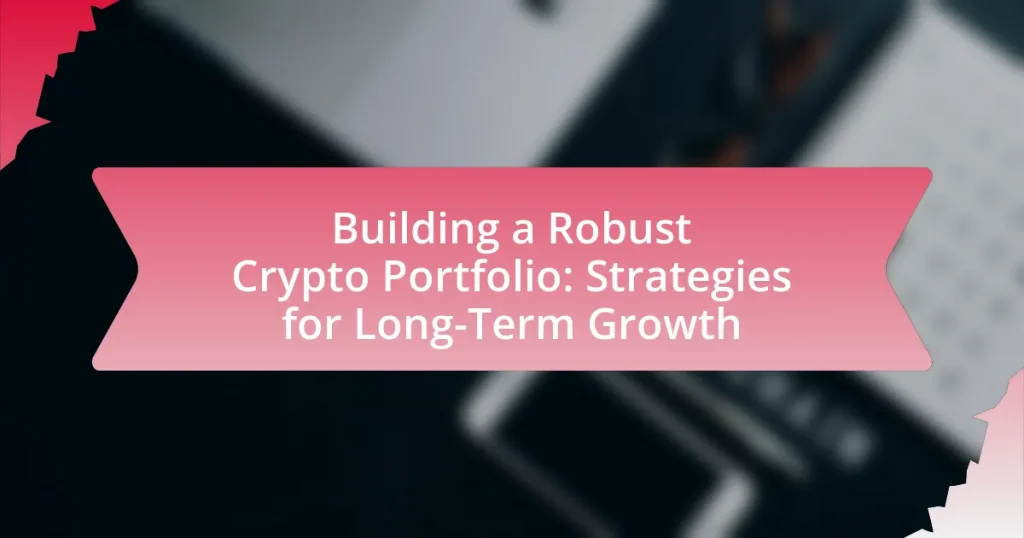Building a robust crypto portfolio involves creating a diversified collection of cryptocurrencies aimed at minimizing risk while maximizing potential returns. Key components include a mix of established cryptocurrencies and emerging altcoins, alongside risk management strategies and regular rebalancing. The article outlines the differences between crypto and traditional investment portfolios, emphasizes the importance of diversification, and discusses strategies for achieving long-term growth. Additionally, it addresses the significance of understanding risk tolerance, conducting market research, and avoiding common pitfalls to enhance investment success in the volatile cryptocurrency market.

What is a Robust Crypto Portfolio?
A robust crypto portfolio is a diversified collection of cryptocurrencies designed to minimize risk while maximizing potential returns. This portfolio typically includes a mix of established cryptocurrencies, such as Bitcoin and Ethereum, alongside smaller, emerging altcoins to capture growth opportunities. The diversification strategy helps mitigate the volatility inherent in the cryptocurrency market, as different assets may respond differently to market conditions. Research indicates that a well-balanced portfolio can enhance long-term growth potential, as evidenced by studies showing that diversified investments tend to outperform concentrated ones over time.
How does a crypto portfolio differ from traditional investment portfolios?
A crypto portfolio differs from traditional investment portfolios primarily in its asset composition and volatility. While traditional portfolios typically consist of stocks, bonds, and real estate, a crypto portfolio is composed mainly of cryptocurrencies and digital assets. Cryptocurrencies are known for their high volatility; for instance, Bitcoin’s price has experienced fluctuations exceeding 10% within a single day, contrasting with the more stable returns generally seen in traditional assets. Additionally, crypto portfolios often lack the regulatory protections and established market structures that traditional investments benefit from, making them riskier. This distinction highlights the unique challenges and opportunities presented by investing in digital currencies compared to conventional financial instruments.
What are the key components of a crypto portfolio?
The key components of a crypto portfolio include a diversified selection of cryptocurrencies, risk management strategies, and regular portfolio rebalancing. A diversified selection typically consists of major cryptocurrencies like Bitcoin and Ethereum, along with smaller altcoins to capture growth potential. Risk management strategies involve setting stop-loss orders and determining the percentage of total capital allocated to each asset, which helps mitigate losses. Regular portfolio rebalancing ensures that the asset allocation remains aligned with investment goals and market conditions, optimizing long-term growth.
Why is diversification important in a crypto portfolio?
Diversification is important in a crypto portfolio because it reduces risk and enhances potential returns. By spreading investments across various cryptocurrencies, investors can mitigate the impact of volatility associated with individual assets. For instance, during market downturns, while some cryptocurrencies may lose value, others may remain stable or even appreciate, thereby balancing overall portfolio performance. Historical data shows that diversified portfolios tend to outperform concentrated ones, as evidenced by studies indicating that portfolios with a mix of assets can reduce risk by up to 30% compared to those heavily invested in a single asset.
What are the main goals of building a robust crypto portfolio?
The main goals of building a robust crypto portfolio are to achieve diversification, manage risk, and maximize returns. Diversification involves spreading investments across various cryptocurrencies to reduce exposure to any single asset’s volatility. Managing risk is essential, as the cryptocurrency market is known for its price fluctuations; a well-structured portfolio can help mitigate potential losses. Maximizing returns focuses on selecting high-potential assets that can appreciate significantly over time, contributing to overall portfolio growth. These goals are supported by the historical performance of diversified portfolios, which have shown to outperform concentrated investments during market downturns.
How can long-term growth be achieved through strategic investments?
Long-term growth can be achieved through strategic investments by focusing on diversified asset allocation, consistent reinvestment of returns, and thorough market analysis. Diversified asset allocation minimizes risk by spreading investments across various cryptocurrencies and related assets, which can stabilize returns over time. Consistent reinvestment of returns allows for compound growth, as profits are reinvested to generate additional earnings. Thorough market analysis, including understanding market trends and technological advancements, enables informed decision-making, leading to better investment choices. Historical data shows that portfolios with diversified assets and reinvested returns have outperformed those with concentrated investments, reinforcing the effectiveness of these strategies in achieving long-term growth.
What risks should be considered when aiming for long-term growth?
When aiming for long-term growth in a crypto portfolio, several risks must be considered, including market volatility, regulatory changes, technological risks, and liquidity issues. Market volatility can lead to significant price fluctuations, impacting the value of investments; for instance, Bitcoin experienced a price drop of over 80% from its peak in 2017 to 2018. Regulatory changes can affect the legality and operational framework of cryptocurrencies, as seen with various countries imposing stricter regulations or outright bans. Technological risks, such as security vulnerabilities and the potential for hacks, can compromise assets; the 2016 DAO hack resulted in the loss of $60 million worth of Ether. Lastly, liquidity issues may arise in less popular cryptocurrencies, making it difficult to sell assets without affecting their price. Each of these risks can significantly impact the long-term growth potential of a crypto portfolio.

What strategies can be employed for building a robust crypto portfolio?
To build a robust crypto portfolio, investors should employ diversification, risk management, and regular rebalancing. Diversification involves spreading investments across various cryptocurrencies to mitigate risk; for instance, holding a mix of established coins like Bitcoin and Ethereum alongside emerging altcoins can balance potential volatility. Risk management includes setting clear investment goals and limits, such as using stop-loss orders to protect against significant losses. Regular rebalancing ensures that the portfolio maintains its intended asset allocation over time, adapting to market changes and individual performance. These strategies are supported by historical data showing that diversified portfolios tend to yield more stable returns compared to concentrated investments.
How can investors assess their risk tolerance for crypto investments?
Investors can assess their risk tolerance for crypto investments by evaluating their financial situation, investment goals, and emotional response to market volatility. A clear understanding of one’s financial capacity, including income, savings, and existing investments, helps determine how much risk can be comfortably taken. Additionally, setting specific investment goals, such as time horizon and expected returns, allows investors to align their risk tolerance with their objectives. Emotional responses to potential losses or gains can be gauged through self-reflection or risk assessment questionnaires, which often categorize investors as conservative, moderate, or aggressive based on their comfort with risk. This structured approach enables investors to make informed decisions that align with their personal risk profiles.
What factors influence an investor’s risk tolerance?
An investor’s risk tolerance is influenced by several key factors, including financial situation, investment goals, time horizon, psychological factors, and market experience. Financial situation encompasses income, savings, and existing investments, which determine how much risk an investor can afford to take. Investment goals, such as retirement or wealth accumulation, shape the level of risk an investor is willing to accept. Time horizon refers to the duration an investor plans to hold an investment, with longer horizons typically allowing for greater risk tolerance due to the potential for recovery from market fluctuations. Psychological factors, including individual temperament and emotional responses to market volatility, significantly impact risk tolerance. Lastly, market experience, or familiarity with investment products and market behavior, can either increase confidence in taking risks or lead to a more conservative approach.
How can understanding risk tolerance guide portfolio construction?
Understanding risk tolerance is crucial for guiding portfolio construction as it helps investors align their investment choices with their ability to withstand market fluctuations. By assessing an individual’s risk tolerance, which can be influenced by factors such as investment goals, time horizon, and emotional capacity for loss, investors can determine the appropriate asset allocation between high-risk and low-risk investments. For instance, a study by Vanguard found that investors with a higher risk tolerance tend to allocate a greater percentage of their portfolio to equities, which historically offer higher returns but come with increased volatility. This tailored approach ensures that the portfolio reflects the investor’s comfort level with risk, ultimately enhancing the likelihood of achieving long-term financial objectives.
What role does market research play in portfolio building?
Market research plays a critical role in portfolio building by providing insights into market trends, investor behavior, and asset performance. This information enables investors to make informed decisions about which cryptocurrencies to include in their portfolios, optimizing for potential growth and risk management. For instance, a study by the CFA Institute highlights that effective market research can lead to a 20% increase in investment returns by identifying undervalued assets and emerging market opportunities. Thus, thorough market research is essential for constructing a robust crypto portfolio that aligns with long-term growth strategies.
How can investors identify promising cryptocurrencies?
Investors can identify promising cryptocurrencies by analyzing their technology, market demand, and team expertise. Evaluating the underlying technology involves assessing the blockchain’s scalability, security, and unique features, such as smart contracts or interoperability. Market demand can be gauged through metrics like trading volume, user adoption rates, and the presence of partnerships or integrations with established companies. Additionally, examining the team’s background, including their experience in the crypto space and previous successful projects, provides insight into the project’s potential for success. For instance, cryptocurrencies like Ethereum have gained traction due to their robust technology and strong developer community, evidenced by the significant number of decentralized applications built on its platform.
What tools and resources are available for market analysis?
Market analysis for building a robust crypto portfolio can be conducted using various tools and resources. Key tools include cryptocurrency market tracking platforms like CoinMarketCap and CoinGecko, which provide real-time data on prices, market capitalization, and trading volume. Additionally, analytical tools such as TradingView offer advanced charting capabilities and technical analysis features. Resources like Glassnode and CryptoQuant provide on-chain data analytics, helping investors understand market trends and sentiment. Furthermore, research reports from firms like Messari and Delphi Digital offer in-depth insights and forecasts, supporting informed decision-making in the crypto space.

How can investors maintain and adjust their crypto portfolios over time?
Investors can maintain and adjust their crypto portfolios over time by regularly reviewing their asset allocations, staying informed about market trends, and rebalancing their holdings as needed. Regular reviews allow investors to assess the performance of their assets and make informed decisions based on changes in the market or their personal financial goals. Staying informed about market trends, such as regulatory changes or technological advancements, helps investors anticipate shifts that may impact their portfolios. Rebalancing involves selling assets that have increased in value and buying those that have decreased, ensuring that the portfolio remains aligned with the investor’s risk tolerance and investment strategy. This approach is supported by studies showing that regular portfolio rebalancing can enhance returns and reduce risk over time.
What are the best practices for monitoring portfolio performance?
The best practices for monitoring portfolio performance include regularly reviewing asset allocation, tracking performance against benchmarks, and utilizing performance metrics. Regularly reviewing asset allocation ensures that the portfolio aligns with investment goals and risk tolerance, as market conditions can shift asset values. Tracking performance against benchmarks, such as relevant indices, provides a clear comparison to assess whether the portfolio is meeting expectations. Utilizing performance metrics, such as the Sharpe ratio or alpha, offers insights into risk-adjusted returns, helping investors understand how well their portfolio is performing relative to its risk. These practices are essential for making informed adjustments and optimizing long-term growth in a crypto portfolio.
How often should investors review their crypto portfolios?
Investors should review their crypto portfolios at least quarterly. This frequency allows investors to assess market trends, evaluate the performance of their assets, and make informed decisions based on changes in the cryptocurrency landscape. Regular reviews help in identifying underperforming assets and reallocating resources effectively, which is crucial for long-term growth. According to a study by Fidelity Digital Assets, 60% of institutional investors believe that regular portfolio reviews are essential for managing risk and optimizing returns in the volatile crypto market.
What indicators signal the need for portfolio adjustments?
Indicators that signal the need for portfolio adjustments include significant changes in market conditions, shifts in asset performance, and alterations in investment goals. For instance, if a particular cryptocurrency experiences a drastic price drop or surge, it may necessitate a reevaluation of its weight in the portfolio. Additionally, if the overall market sentiment shifts from bullish to bearish, this could indicate a need to reduce exposure to riskier assets. Furthermore, changes in personal financial circumstances or investment objectives, such as nearing retirement or a change in risk tolerance, also warrant portfolio adjustments. These indicators are crucial for maintaining alignment with long-term growth strategies in a dynamic crypto market.
How can investors rebalance their portfolios effectively?
Investors can effectively rebalance their portfolios by regularly assessing their asset allocation and adjusting their holdings to maintain desired risk levels. This process typically involves selling assets that have exceeded their target allocation and buying those that have fallen below it, ensuring alignment with the investor’s risk tolerance and investment goals. Research indicates that rebalancing can enhance returns and reduce risk; for instance, a study by Vanguard found that a disciplined rebalancing strategy can improve long-term performance by maintaining a consistent risk profile.
What methods can be used for rebalancing a crypto portfolio?
Methods for rebalancing a crypto portfolio include periodic rebalancing, threshold rebalancing, and dynamic rebalancing. Periodic rebalancing involves adjusting the portfolio at regular intervals, such as monthly or quarterly, to maintain target asset allocations. Threshold rebalancing triggers adjustments when an asset’s weight deviates from its target by a predetermined percentage, ensuring that no single asset dominates the portfolio. Dynamic rebalancing adjusts allocations based on market conditions and asset performance, allowing for more responsive management. These methods help maintain risk levels and align with investment goals, contributing to long-term growth in a crypto portfolio.
Why is rebalancing crucial for long-term growth?
Rebalancing is crucial for long-term growth because it helps maintain an optimal asset allocation that aligns with an investor’s risk tolerance and investment goals. By periodically adjusting the portfolio to its target allocation, investors can mitigate risks associated with market volatility and prevent overexposure to any single asset class. Historical data shows that portfolios that are regularly rebalanced tend to outperform those that are not, as they capitalize on market fluctuations and ensure that gains are locked in while losses are minimized. For instance, a study by Vanguard found that rebalancing can enhance returns by an average of 0.5% annually, demonstrating its effectiveness in promoting sustained growth over time.
What are common pitfalls to avoid when building a crypto portfolio?
Common pitfalls to avoid when building a crypto portfolio include over-concentration in a single asset, neglecting research, and failing to diversify. Over-concentration can lead to significant losses if that asset underperforms; for instance, if an investor allocates 80% of their portfolio to one cryptocurrency, a downturn in that asset can severely impact overall returns. Neglecting research can result in poor investment choices; studies show that informed investors tend to achieve better outcomes. Lastly, failing to diversify increases risk; a well-diversified portfolio can mitigate losses, as different assets often react differently to market conditions.
How can emotional decision-making impact investment choices?
Emotional decision-making can significantly impact investment choices by leading to irrational behaviors such as panic selling or euphoric buying. Investors often allow emotions like fear and greed to dictate their actions, which can result in poor timing and suboptimal investment strategies. For instance, a study published in the Journal of Behavioral Finance found that investors who exhibit high emotional responses tend to underperform compared to those who maintain a rational approach, as they are more likely to make impulsive decisions based on market fluctuations rather than fundamental analysis. This emotional volatility can undermine the long-term growth potential of a crypto portfolio, as it may cause investors to deviate from their strategic plans and miss out on opportunities for sustainable gains.
What mistakes do novice investors often make in crypto?
Novice investors often make the mistake of failing to conduct thorough research before investing in cryptocurrencies. This lack of due diligence can lead to poor investment choices, such as buying into projects with weak fundamentals or high volatility. According to a 2021 survey by the Financial Industry Regulatory Authority (FINRA), 47% of investors reported not fully understanding the risks associated with cryptocurrencies, highlighting the importance of education in making informed decisions. Additionally, novice investors frequently fall victim to emotional trading, reacting impulsively to market fluctuations rather than adhering to a well-defined investment strategy. This behavior can result in significant financial losses, as evidenced by the high percentage of retail investors who sell during market downturns, often at a loss.
What practical tips can enhance the success of a crypto portfolio?
To enhance the success of a crypto portfolio, investors should diversify their holdings across various cryptocurrencies to mitigate risk. Diversification reduces the impact of poor performance from any single asset, as evidenced by the fact that Bitcoin, which constituted over 60% of the total crypto market cap in early 2021, can be volatile, while altcoins may perform differently under various market conditions. Additionally, regularly rebalancing the portfolio ensures that the asset allocation aligns with the investor’s risk tolerance and market changes. Research indicates that portfolios rebalanced quarterly can outperform those that are not adjusted, as they capitalize on market fluctuations. Furthermore, staying informed about market trends and technological advancements in the blockchain space can lead to better investment decisions, as the crypto landscape is rapidly evolving.
How can setting clear investment goals improve portfolio outcomes?
Setting clear investment goals significantly improves portfolio outcomes by providing direction and focus for investment decisions. When investors establish specific, measurable, achievable, relevant, and time-bound (SMART) goals, they can better align their asset allocation and risk tolerance with their financial objectives. Research indicates that investors with defined goals are more likely to stick to their investment strategies and avoid emotional decision-making, which can lead to suboptimal performance. For example, a study by the CFA Institute found that goal-oriented investors tend to achieve higher returns over time compared to those without clear objectives, as they are less likely to react impulsively to market fluctuations.
What role does continuous education play in successful investing?
Continuous education is essential for successful investing as it equips investors with updated knowledge and skills necessary to navigate the evolving financial landscape. In the context of cryptocurrency, where market dynamics change rapidly, ongoing learning helps investors understand new technologies, regulatory changes, and market trends. For instance, a study by the CFA Institute found that investors who engage in continuous education are more likely to achieve better investment outcomes, as they can make informed decisions based on the latest data and analysis. This commitment to learning fosters adaptability and enhances risk management, ultimately contributing to long-term growth in a robust crypto portfolio.















